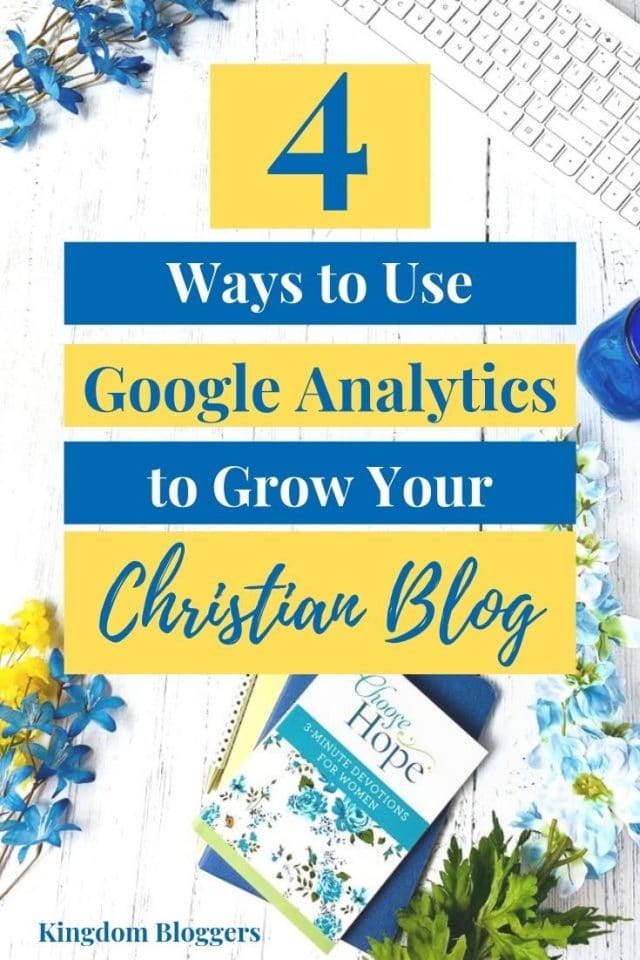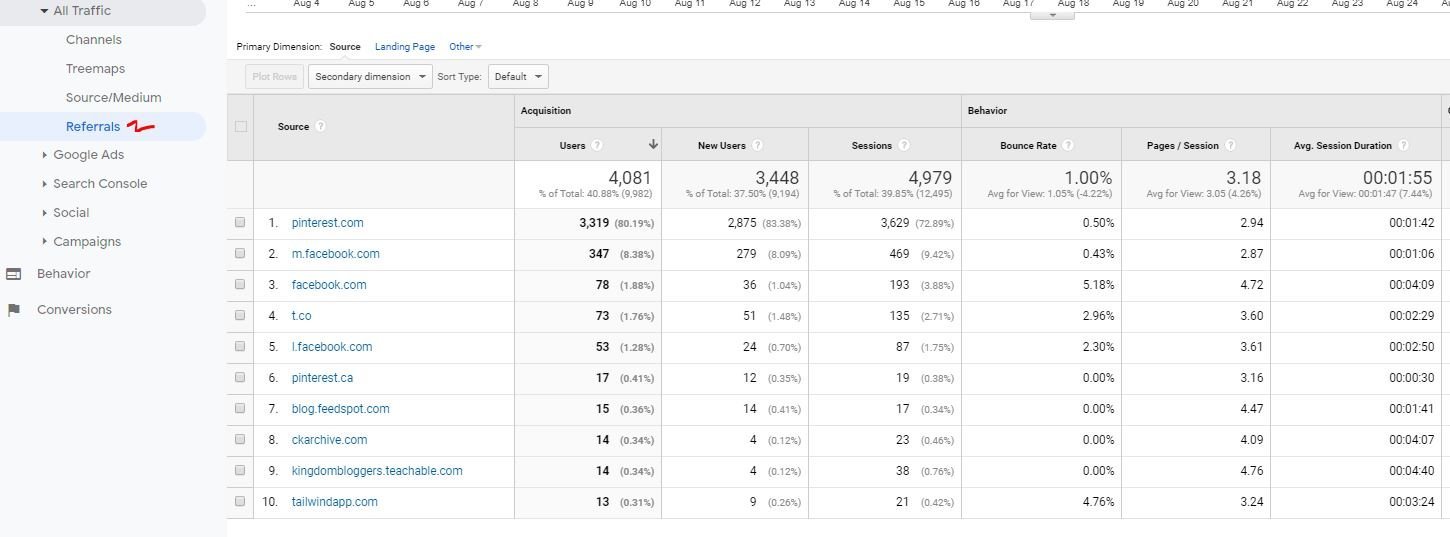In order to grow a successful Christian blog ministry, you need to know what you are doing right and what areas can be improved upon. The easiest way to figure this part out is by tracking your blog’s performance in Google Analytics. While diving into Google Analytics might be a bit overwhelming, I’ve broken it down into 4 key areas for you to monitor and keep track of to help improve your blog’s performance.
BE SURE TO PIN ME FOR LATER!
This post may contain affiliate links. You can read my full affiliate disclosure here.
4 Things to Track in Google Analytics
1. General Monthly Site Stats
You’ll find this information right when you log into your GA dashboard. By default, it shows stats for the last 7 days, but you can change that to the last 30 days or a different time-frame to monitor.
What you’ll find on this graph:
- Users – Total number of users during the specified date range who initiated at least one session.
- New Users – Total users who were first-time visitors to the site during the specified date range.
- Sessions – Total actual visits to the site. If an individual user comes back to the site for a subsequent visit, this registers as 2 sessions.
- Sessions per User – Average number of sessions by individual users during the date range.
- Page Views – Total number of pages viewed on your site. If a single user arrives via single post and clicks through to read another post, and then another, this would register as 3 total page views.
- Pages/session – The average number of pages a reader engages with during each visit (session) to the site.
- Session Duration – The average time a person stays on your site during a single session.
- Bounce Rate – This number is calculated based on a reader landing on a page/post and not taking any further action before leaving your site. This means they don’t share, comment, click through to another post, etc.
Generally speaking, you want your sessions to be higher than your users because that means some of your individual users are returning for additional visits to your site. For Page Views, you’ll want to see this number reach double, triple (or higher) the number of users or sessions because that means your readers are clicking through and reading/engaging with more of your content.
A high bounce rate can indicate a number of things. At face value, a high bounce rate could indicate that readers just aren’t interested in your content. More often, that is not the case. It is usually the result of not having your content laid out in the best way for users to navigate around. Other reasons could be that the content doesn’t truly fulfill what the title implies.
2. Where Your Traffic is Coming From
Now that you have a basic understanding of some of the main terms associated with GA, it is important that you know exactly where your traffic is coming from. This is important for a number of reasons. Most importantly, it can help you determine if the promotional methods you are currently focusing on are actually benefiting you.
SOURCE/MEDIUM
To get to the view in the image above, go to Acquisition – All Traffic – Source/Medium.
This shows you the top 10 sources of your traffic for a given time period. Your long-term goal, of course, is to get more organic traffic from Google and other search engines (Yahoo, bing, etc) because that means your SEO is working. But before your SEO even takes effect, you can still get significant traffic from other sources such as Pinterest, social media, etc.
The default view lists the top 10 sources but you can expand it to show more.
As you can see, I’m currently getting organic traffic from Google, Bing, and Yahoo, in addition to substantial Pinterest.
There are multiple Facebook and Pinterest sources (depending on how exactly the link to your site was acquired through these sources.) (t.co is traffic from Twitter)
By seeing exactly how your visitors are getting to your site, you can see if your time is being spent on the right platforms. Something to keep in mind for Facebook traffic is that your actual blog Facebook page – which many people do spend a lot of time on – might not actually be the driving force. If you are participating in share threads in different blogger groups, etc., this traffic could be coming from there. To see how your Facebook page is really doing, you need to look at the analytics inside your Facebook page (not Google Analytics).
REFERRAL TRAFFIC
This next view will show you 3rd parties that are referring traffic your way. This view doesn’t include organic searches from search engines, but other sites that are directly referring readers your way. In this view, you’ll find your social channels, other blogs and websites, as well as spam referrals.
To get to the view in the image above, go to Acquisition – All Traffic – Referrals.
You’ll often see multiple Pinterest and social media referral sources, your email management service, Tailwind, as well as other bloggers who have linked to your site. When I find other bloggers have linked to a post, I’ll go check out their post (if I wasn’t already aware of it) and reach out to thank them for including my content in their post. I may even return the favor by linking the referring post from the post it is linking to (giving them return traffic from my site visitors).
In this view, you can also track down the particular posts/pins that are sending the traffic. Simply click on “Pinterest” and the next page will list all the pin URL’s with a little box out to the side that you can click on. It will then give you a pop-up of the actual pin.
You can do the same with any of the other referrers and it will show you the specific posts from that platform that traffic is being referred to.
MOBILE VS DESKTOP USERS
While you may not think that knowing which type of device your readers are visiting you from matters – IT DOES!! More and more people use tablets and phones as a primary method of getting online. If you know that the majority of your readers are from some type of mobile device, this can impact how they actually are able to view your site. Things like pop-up subscription forms can really cause problems for mobile readers. Also, your mobile readers don’t really see what is in your sidebar. So if you are putting a lot of vital information on your sidebar but not elsewhere, your mobile readers might miss out on it.
You can clearly see that Kingdom Bloggers gets about 80% of the traffic from some type of mobile device/tablet. Because of this, I disable pop up forms for mobile users. If you see that your mobile or tablet users have a super-high bounce rate, this could indicate that something isn’t working well for your mobile readers. You should always visit your site from your phone/tablet to make sure everything is working smoothly for your readers.
3. How Content is Doing
Regardless of what view you are looking at, you’ll almost always have a column showing the bounce rate for that referral source or specific URL. Some social platforms will always have higher bounce rates than other sources because people are often just scrolling when on social media and may not have the time to actually read through the content.
- Mobile vs Desktop – We covered this one already, but basically, if you see that your mobile traffic seems to have an unusually high bounce rate as compared to your desktop traffic, this could be an indication of your site not being mobile responsive. Visit your site from your mobile device often to ensure everything displays in a manner that doesn’t distract readers.
- Pinterest – If you see that your Pinterest traffic seems to have a high bounce rate, you’ll want to investigate this further. From Acquisition – All Traffic – Referrals, you can click on “Pinterest” and the top Pin URL’s will be displayed. You can then look to see if one or more of them is showing a higher bounce rate than the others. If so, investigate that pin in relation to the post content. Many times we put titles on pins that don’t adequately sum up the actual content of the post. For example, if your pin said “5 Ways to …..” then it would be expected that your content had “5 Ways” clearly listed in the post. Other reasons could be that the actual post doesn’t have any internal links for the reader to click on (causing them to “bounce” from the page).
- Direct/organic – If you are getting significant traffic to a particular post from Google or other search engines but it has a high bounce rate, take a hard look at the post. Does the content really offer help in the way of what the title implies? Is the content laid out in an organized manner that a reader can clearly follow? Are there plenty of internal links in the post for a reader to click through to additional content? If you can’t find anything wrong with the post, ask a trusted friend or fellow blogger to have a peek at it.
#4 How is Your SEO Doing?
While social sharing and Pinterest are great for short-term blog growth, your ultimate strategy for long-term growth is to have consistent organic traffic from search engines. This happens by having a solid SEO strategy for your site. This includes:
To see how your SEO strategy is working and what keywords are actually driving traffic to your site, you can dive deeper into Google Analytics to find out!
In your GA dashboard, go to Acquisition – Search Console – Queries. The default view will show the top 10 referring keywords but you can expand it to show more. If you haven’t connected this yet, you’ll be prompted to do so and GA will then begin tracking this information for your site.
If you are connected and aren’t really showing anything here, then you need to really step back and look at your SEO strategy!
As you can see, eventually, you’ll begin showing up for a variety of related terms that aren’t necessarily the exact ones you’ve written posts for. This is a good thing because that means that Google is “putting 2 and 2 together” so that when someone searches something similar to yours, it will put yours in the search results.
This information is helpful because it can give you new ideas for writing additional content on topics your readers have proven to most interested in.
Google Analytics is a Great Tool!
Growing your Christian blog ministry requires a plan and that plan includes evaluating and re-evaluation everything you are doing. Google Analytics is a great tool for figuring all this out. Yes, it can be a bit overwhelming trying to sift through the massive amount of data, but knowing some of the key areas to keep tabs on really makes it easier to navigate.
Begin by focusing on the four key areas in the dashboard and that will get you off to a great start. Knowing where your traffic is coming from and what keywords are getting traffic to your site can really help you focus a solid strategy for growing your site!
Related: How to Set Up Google Analytics and Search Console.






